|
Monday, September 23, 2013
Progress Notes
My last Progress Notes article for our website was uploaded October 29, 2012. Since then Judy and I have been traveling visiting our children, Jennifer and Dan and their family in Barrington, Illinois and John and his wife, Megan, in Amesbury, Massachusetts, as well as a couple of cruises, one which took us all around the periphery of South America and a second one in which we explored the coastal areas of northern Europe, Greenland and Iceland. To be away from home for such a long time meant I had to give up some of my activities including writing the weekly Progress Notes series for our website. However, I do plan to upload to my page on our website an article once in a while as time permits, and in fact, I have just completed a new Progress Notes article about a very well liked physician who in 1933 began a practice in Brumley, Missouri. His name was Dr. Myron Douglass Jones (photo 01).
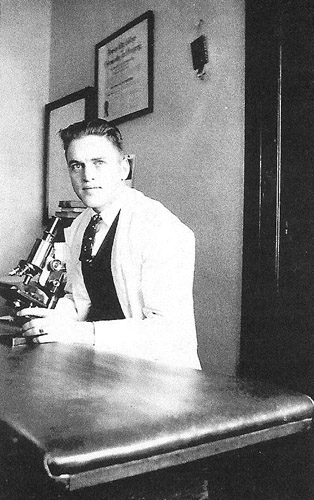
01 Dr. Jones in Office
I had known about Dr. Jones early on because he had home delivered the first three babies of my wife Judy’s mother, Elva Boyd Steen. But rather serendipitously this year I happened to meet the daughter of Dr. Jones, Margaret (Jones) Johnson, who with her husband, Pete Johnson, were traveling with us on our cruise around South America (photo 02).
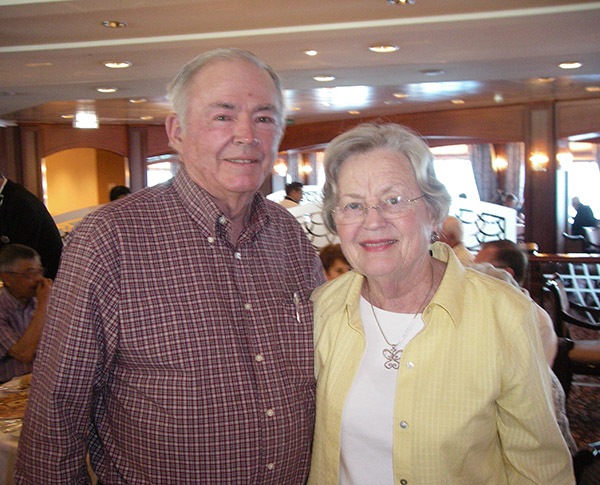
02 Pete and Margaret Johnson, Daughter of Dr. Jones
Margaret remembered Brumley very well as she had attended school there for several years before the family moved to Kansas City in the late 1940’s.
I had mentioned Dr. Jones briefly in my Progress Notes of May 25, 2007 which featured the career of Dr. Marshall Humphreys of Tuscumbia (photo 03):
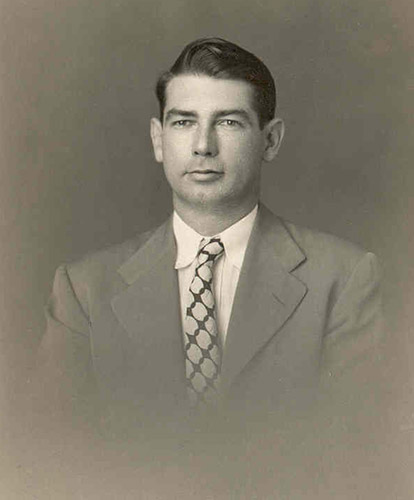
03 Doctor Marshall Humphreys
Dr. Jones and Dr. Humphreys both were Osteopaths and knew each other well. In fact, Dr. Jones, who arrived in Miller County, first, advised Dr. Humphreys of the need for a physician in Tuscumbia which provided the incentive for Dr. Humphreys to come here. Dr. Jones' wife's name was Marjorie, and it so happened that Dr. Humphreys' first daughter was named Marjorie. Dr. Humphreys' wife's name was Margaret, and it so happens that Dr. Jones' first daughter was named Margaret. My mother-in-law Elva Boyd Steen, who was from Ulman, told me that a number of people thought the names were given as a sign of the friendship between the two families.
Margaret (Jones) Johnson, Dr. Jones’ daughter, upon arrival home from our cruise, sent me some photos of Dr. Jones and a narrative her father had typed about himself and his family’s years in Brumley, where he practiced medicine from 1933 to 1947. These photos begin with Dr. Jones as a baby, after graduation from the School of Osteopathy and with his family (photos 04, 05 and 06):
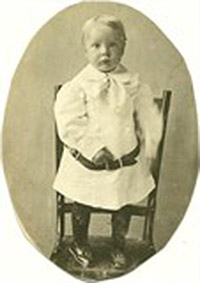
04 Dr. Jones Baby Photo
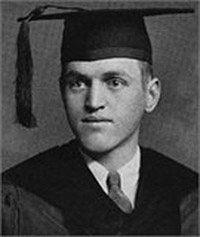
05 Dr. Jones Graduation Photo - College of Osteopathy and Surgery, Kansas City
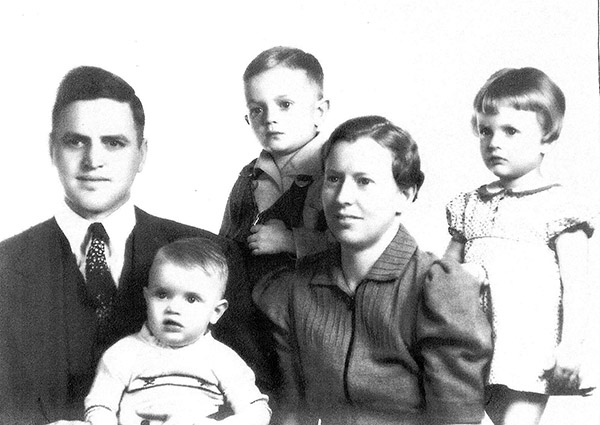
06 Dr. Myron and Margorie Jones, Myron Jr., Margaret and Phillip - 1939
Dr. Jones’ memories about his years practicing in Brumley are written as a series of anecdotes about many of his more interesting patients. I imagine many older residents of the Brumley area will know quite a number of the local citizens whom Dr. Jones remembers. The following narrative presents Dr. Jones’ autobiography beginning with his early childhood in the State of Washington where he grew up as a child and continuing to the time of his years in Brumley; all of which he himself typed:
Dr. Myron Jones Autobiography
In order to fall a tree you did three things: you would saw into the tree about six or eight inches depending on the size, remove the saw and with an axe chop out the wood above the saw cut; this was what is known as “facing,” then you would saw on the opposite side to within an inch or two of the “facing.” If the tree was leaning in the direction you wanted it to fall it would fall of its own weight; otherwise, if it was leaning opposite to the direction you wished it to fall, otherwise, if it is leaning opposite to the direction you wish it to fall then you would have to drive wedges behind the saw. Always one has to worry about a heavy limb 150 feet above you snapping off and come hurtling down on your head. Three times in the winter of 1924-1925 one of these “widow makers” fell just beside me. This was long before the days of hard hats.
When June of 1925 came, Uncle Homer needed some one to help him with his forty acres of Cuthbert Raspberries (photo 07).

07 Cuthbert Raspberries
It was necessary to cut the dead vines of the year before and throw them in a hopper for burning. The vines were in long rows, the rows far enough apart to run a disc pulled by a Fordson Tractor through (photo 08).
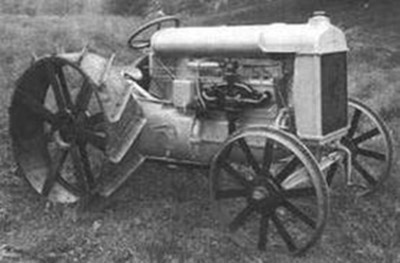
08 Fordson Tractor
First, I disked the whole field after the pruning and placing the current vines inside wires that ran on the outside of posts. Then I planted several kinds of grass and clover seeds. When the grass and clover had grown to a height of about six inches, I went in with a two bottom plow and turned it all under bringing the dirt toward the plants (raspberries). A week later this was all disced in a manner in which the blades of the disc pulled the dirt away from the plants. Then several of us would go into the field and hoe all the weeds and grass missed by the disc.
The berries would begin to ripen about the middle of June. It was my job to drive into Portland, Oregon to hire the berry pickers that had answered the ad in the paper as well as hire the pickers of the year before that had expressed a desire to repeat their work with us again. Usually, the pickers were housewives whose husbands were rail roaders. The wives would bring all their children big enough to pick berries; the family would live in a tent that Uncle Homer had provided in the cherry orchard. I would drive the 13 miles into the city usually to pick up two families in Uncle Homer’s truck, bring them back to the farm and assign them a tent to each family. As the season went on the berries were more and more plentiful, and at the height of the season it required as many as 45 pickers. After the day’s work was finished I would load the crated into the truck and drive two miles to the cannery in Gresham. During the six weeks of the harvest time I trucked 96,000 pounds of red raspberries to the cannery. That’s a lot of jam!
When I was graduated from high school, my Uncle Jim and Aunt Margaret Jones had invited me to stay with them while attending the Kansas City College of Osteopathy and Surgery. This was an opportunity too good to pass up so in August of 1925, I left Gresham to take up my studies in Kansas City. My classes began at 8 a.m. and continued until 1 p.m. This permitted time for afternoon employment. The college dean bragged about the fact that the students for the most part worked their way through college. My first job was as a clerk in a drug store. Then I went to work for the Ryan Manufacturing Company for $10.50 a week. The drugstore only paid me $5.00 weekly. My job with the factory was to deliver mattresses to the Jones Store Company as well as homes in the Kansas City area. Several of the other students were getting jobs delivering the Kansas City Journal-Post. It was in the spring of 1926 that I was able to get one of these routes with the help of Grandmother Jones who loaned me one of her U.S. Government bonds to put up as a bond to the Journal-Post. There were 13 deliveries a week which cost the customer 15 cents. I was required to pay the newspaper 6 cents; hence my profit was 9 cents. The route extended from 24th and Forest over to Woodland Avenue and south to 27th street. I had on the average of 450 customers, 150 white patrons and 300 black. I would arise every morning at 3:30 to be on hand when the truck delivered the bundles of papers at 24th and Forest and at 24th and Vine streets. Also, I had to be on hand at 4 p.m. for the evening edition. There was only one Sunday edition early in the morning. The worst feature of the job was collecting the 15 cents from the customers. Most people were honest but there were a few that tried to evade payment. The people in that section of town moved frequently and just as frequently forgot to pay the paper boy.
With so much travelling that the job entailed it was necessary to buy a car. I found a good used Model T which served my purpose just fine (photo 09).
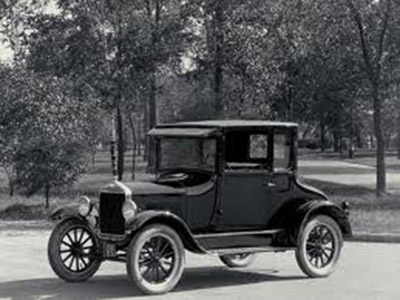
09 Model T Ford
When I brought the car home I looked under the back seat and found a set of home made tools. I called Uncle Jim to show him my find. He picked up the first one then another of the tools as if they were almost sacred. He told me that about a year before someone had broken into his car and stolen all his tools; these were the tools he had made while working for the Southern Pacific Round House in Tucson, Arizona. He was happy to get them back!
The Kansas City Journal-Post decided to break up the paper routes into smaller units and hire high school boys to do the deliveries. The paper returned the bond I had put up so I had to find other employment. This was my last year in college, the fall of 1928. One of my classmates had a job with the Kansas City Club; he suggested that I apply there for a job. So I became a bell hop for $54.00 a month.
During the Thanksgiving vacation I became ill with influenza; this became complicated with otitis media, mastoiditis, meningitis, and a purulent gall bladder. It was in January of 1929 that the doctors at Lakeside Hospital told Aunt Margaret and Uncle Jim that I was in a critical state due to the meningitis (photo 10).
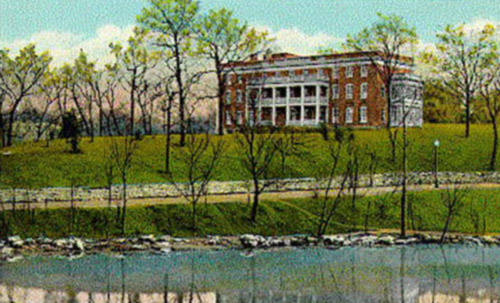
10 Lakeside Hospital, Kansas City, MO
Aunt Margaret called my mother to tell her; she spent the rest of the night praying for me. About 4 a.m. she felt a sense of peace come to her; she knew that I was going to get well. The next morning Dr. Larimore reported that I had passed the crisis and would soon be out of the hospital. At the advice of my doctors I didn’t go back to my job with the Kansas City Club. I was able to graduate on the 24th of May with my class. On June 1, 1929 I began serving as an intern at the Lakeside Hospital. At that time, Drs. J.L. and Margaret Jones made room for me to have a space in their suite of offices in the Altman Building (photo 11).
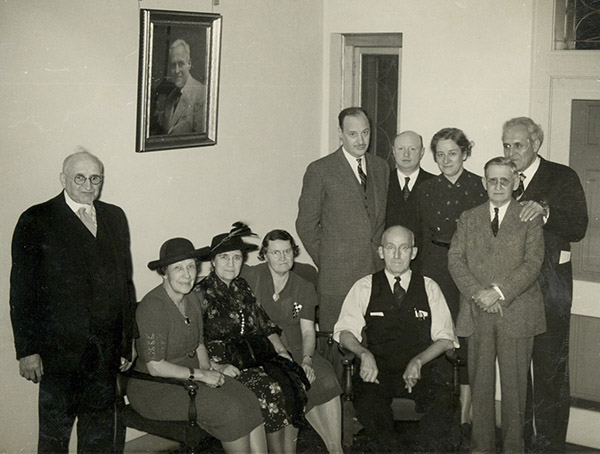
11 Dr. Margaret Jones - 2nd to left of seated man
Note: Photo 11’s complete caption is:
“This picture of the 1936 Board of Trustees was taken inside the front door of Conley Hospital. Dr. George Conley is standing at the far right. The seated man is Dr. A.A. Kaiser one of the founders of KCCOS in 1916 and was the Board Secretary until his retirement in the 1940s. Seated to his right is Dr. Mamie Johnston first graduate of the school and a member of the faculty for 47 years. To her right is Dr. Margaret Jones another longtime faculty member. The woman to her right is Dr. Hanna Leinbach and the man on the far left is Dr. L.R. Livingston, both original Board members from 1916."
I was paid no salary as an intern but was able to support myself on the several patients that came my way. One of the first patients that I saw after graduation was one of Dr. Larimore’s patients that lived in Overland Park. She had developed a high fever of 105 degrees. In doing the differential blood count, Dr. Povlovich, the Pathologist saw some plasmodium amoeba suggesting a diagnosis of malaria. She responded dramatically to quinine. During my college years I had not paid much attention to the study of malaria because the instructors had told us that unless we went south to practice we would never see a case of malaria. It was about a month later I was called to see a 12 year old boy at 82nd and Main in Kansas City with a history of fever of 104 degrees for ten consecutive days, always at the same time of day: 4:00 p.m. They had called another doctor ten days earlier and he had seen him daily but no results. I made a house call to see him, and picked up a thick blood smear besides the usual blood count and urinalysis. Dr. Povlovich found this plasmodium in his blood also. This boy responded to quinine quite dramatically, also.
After finishing my internship I continued to build up a practice but I was still living with Uncle Jim and Aunt Margaret where I also had my office. In March of 1932 things happened to change my entire life. On March 12, 1932 my 16 year old sister died of the complications of Scarlet Fever. I bought a ticket for Grants Pass, Oregon to attend her funeral. I found that Mother and my brother, Terry, both were convalescing from Scarlet Fever. I stayed on to attend them for a week until they improved.
When I returned to Kansas City toward the end of April, I found Dr. J.L. and Margaret struggling to make ends meet. It was in the worst of the depression years. Whereas they had been making between $700 to $1000 monthly, the income had dropped to $250 to $300 a month. Just at this time an appeal had come from a long time friend, Dr. Grace Simmons of Milan, Missouri. She had injured her back en route to a delivery; she wanted someone to help her in her office for a period of three weeks, when she thought she would be able to return to work. After a short discussion it was decided that I would be the one that could most easily go. So on June 1, 1932, I went to Milan to live in the house where Dr. Grace Simmons lived along with her grown son, his wife and his son, Bob. Dr. Simmons’ son was older than I but hadn’t been able to find work, so was dependent on his mother. He was a “Ham” operator of a short wave radio and would spend most of his time in the basement listening and talking to other “Hams” throughout the world. This stood him in good stand for later he went to Kirksville and operated the radio for the airport there until he retired. Helen, Bob’s wife, did a good job of running the house, but hated the fact that everything depended on Dr. Grace’s largess. Billie, Bob’s and Helen’s son, was about six or seven when I went to Milan. He much later graduated from college with a major in sports. He became a coach in football in some of the high schools in northern Missouri where he turned out several championships. About twenty years ago he was hired by the St. Louis Cardinal’s football team to take care of all their equipment. As far as I know, he may still be there.
I was the only active D.O. in Milan in competition with three M.D.’s. The doctors were: Garner, Hixson and Montgomery. These doctors were very ethical; they would consult with me on the few occasions I asked them. However, it was easy to take a patient in my car the 36 miles to Kirksville where there were two Osteopathic Hospitals and one Medical Hospital. Dr. Grace had established friendly relations with all three, so I was treated royally wherever I went. It was while watching a girls’ basketball game in the Milan High School Gym that I saw a girl forward that was a sensational player. She seldom ever missed making points when the ball came to her. The next day I was remarking to a native what a wonderful player Bertha Shatto was. The person I was talking to admitted that Bertha was good but not as good as her older sister, Margorie. It wasn’t until Thanksgiving that I met Marjorie at Sam Loder’s home. Bertha Loder had asked me out for Thanksgiving dinner and at the same time had asked Marjorie who lived next door. All I can say is that Bertha Loder was a successful match maker!
Marjorie and I would continue to meet at church every Sunday, and then I would drive her fifteen miles to where she was teaching at the Green Valley School. At the end of the school year she went to Kirksville State Teachers’ College where she was working toward a teaching certificate. One evening while we were parked on the college campus I proposed that we get married. How fortunate for me she accepted my proposal!
Dr. Grace Simmons’ health improved to the point that I was needed no longer so on August 7, 1933 I went back to Kansas City without any definite goal in mind. Dr. Margaret had a patient that formerly lived in the Ozarks who knew of a town that was trying to get a doctor to locate there. Dr. Margaret and I drove down to look the situation over and found a thriving little town of 125 persons named Brumley, Missouri. After interviewing with most of the town’s prominent families, I decided that I would open an office in town. We were referred to see the town barber who had two rooms to rent for $10.00 a month. They would board me for another $1.00 a day. After returning to Kansas City I made arrangements to leave for Brumley the 12th day of December, 1933. In one of the two rooms I used was an office, the other was the waiting room and bedroom. There was no electricity in Brumley but we had an enterprising garage owner, Ted Stamper, who wanted electricity to operate several power tools available to him (photo 12).
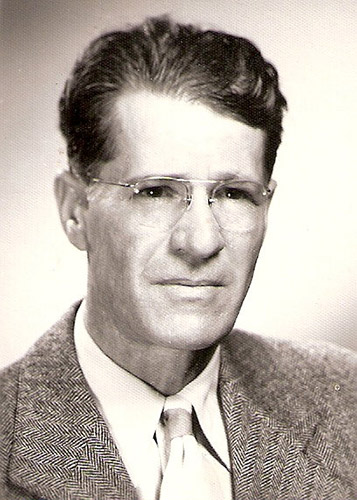
12 Ted Stamper
So he came across a generator which he hooked to a motor car engine. This worked out fine. Then he strung wire a half block to his home. I asked him if he would wire up my office, which he agreed to do. I was his first commercial customer. He soon found that the gasoline motor was using a gallon of fuel every hour. Gasoline was costing 16 cents a gallon then. I read in an industry publication that Witte Engine Company of Kansas City had developed a small diesel engine that was economical on fuel. A month later Ted bought the diesel and thereafter we had electricity we could depend on…or so we thought! More and more families began to buy electricity from Ted Stamper and then when they wired up the brand new high school gymnasium we found that when the flood lights in the gym were on, our refrigerators would stop running. So every night when we had a basket ball game we would unplug our appliances. Ted bought a second generator and a second Witte Engine which helped some but it wasn’t until my best friend from Kansas City brought a mutual friend who was an electrical engineer down for a visit that we got the service we wanted. The engineer, Marvin Freeland, was interested in rural electrification as he was employed by the government to devise plans for the Rural Electrification Authority. After a short study of Brumley’s power plant, he told Ted, “Ted, this is a three phase motor but the way you have it wired you are only using one phase. Now if you will wire it like I will show you, you have all the power you need.” After that we never had any lack of power. Eventually, REA (Rural Electrical Association) came in and bought Ted’s franchise for $18,000.00!
In making the change from Milan to Kansas City to Brumley I hadn’t earned any real money for several months so I had let my payment on the Chevrolet Coach lapse (photo 13).
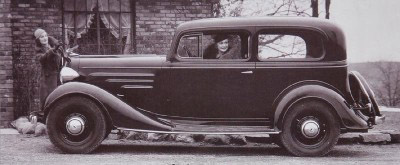
13 1934 Chevrolet
In April of 1934 the finance company sent two men to Brumley where they without ceremony picked up my car and drove away. There I was in an area where house calls were the biggest part of practice and I had no car. One of the families that lived a mile out of town heard of my dilemma and offered to sell me a surplus Ford Model T Roadster (photo 14).
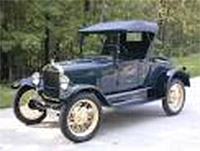
14 Ford Model T Roadster
It had no top and the lid to the little trunk was gone. However, the engine worked well. He asked me $15.00 for it, so I paid him $5.00 down and drove it home. Two weeks later a high school student by the name of McClaskey offered me a trade of his Ford Model T Coupe. It had glass all around so it would get me out of the rain (photo 15).
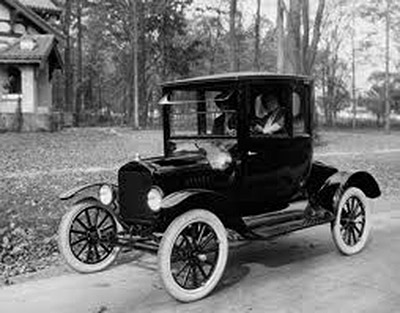
15 Ford Model T Coupe
His offer was accepted: my car plus $20.00 for a total of $35.00. This car ran real good but it had no heater for the cold weather. The windshield wiper had to be operated by hand. The little trunk on the rear had a lid on it so I could get my grip out of the weather. There was no speedometer so I had no idea of how fast it would go. With the throttle wide open on a down hill run it could go up to fifty miles per hour. On a trip, by estimating the time elapsed by the miles between cities, we would average about 35 miles per hour.
One night the door bell rang, a middle aged man said that his 16 year old daughter was in labor. He asked me to deliver the baby. I asked him if he had any of the neighbor women there to help out. He said no and that he didn’t want any. When we arrived at his home about 2 miles of town, the only help I had was the girl’s mother. The labor was short and easy but just as the baby was born the girl’s mother fainted. This left just me to take care of the baby, bathe the new mother, change sheets on the bed…the whole bit! When I was ready to leave he asked me for my bill; when I told him $20.00, he offered me the equivalent in hams and bacon. Home cured ham was selling at 15 cents a pound then. Bacon was the same. I went home with 82 pounds of ham and 58 pound of bacon. The meat all came from one sow that weighed 600 pounds at the time of butchering. The hams weighed slightly over 40 pounds each and the slab of bacon measured about 30 inches by 36 inches. Soon after the baby came the farmer sold his farm and moved to the State of Washington. He could not face his neighbors. Six years later the mother wrote me a letter wanting me to fill out a birth certificate writing in the name of the father of her child. She was embarrassed that her child was different from those of his class mates in school. With regret I wrote her that the only way that I would write in the father’s name on the birth certificate was to have her go to court before a judge and have him make the decision as to who the father was; only then could I name names. That was the last I heard from her.
On the fourth of July, 1934, a man drove up to my office very excited. A friend of his had tried to swim across an arm of the Lake of the Ozarks while in an inebriated condition, had gone under but was rescued several minutes later. He had several friends with him that began artificial respiration while this man came to get me to come to the scene. I agreed to go and started toward the Ford Coupe parked nearby. He said, “No! No! I’ll drive you.” So I got in with him much to my chagrin for I discovered that he was more than a little inebriated himself. He had a narrow escape from going over a high cliff enroute to the scene of the accident. But we made it to McClain’s Camp where we borrowed a speed boat to whisk us across the lake (photo 16).
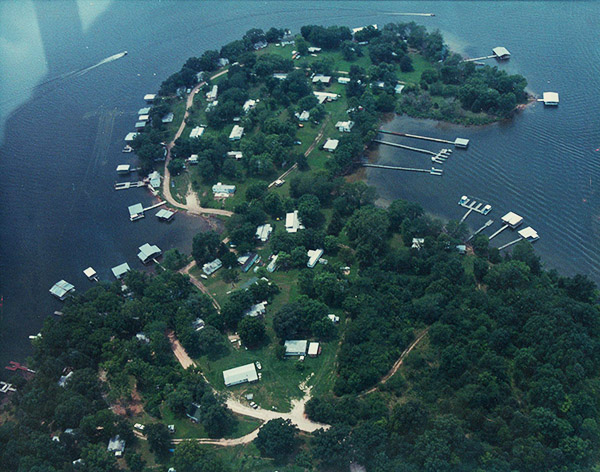
16 Aerial View of McClain Camp - 19 Acres
We arrived at the beach where the drowned man lay. We continued the resuscitation for an hour longer but his heart finally stopped beating. This was the only drowning victim I attended in the 44 years of my practice.
It was time to start preparations for our wedding now set for August 12, 1934. Needless to say, I still hadn’t accumulated any money to speak of. I went to a jewelry store in Eldon to buy an engagement and wedding ring. The only set he had in my financial situation was for $50.00. I paid him $5.00 down and promised to be faithful in my payments. I was able to make the last payment about six months after we were married. I told the jeweler that I was marrying a wonderful girl who was a real beauty. The first trip to Eldon to make a payment after we were married, he agreed with my description of her. Not only that, but she has become more beautiful with the passing years. Now after 49 years of married life she is enchanting!
August 10, 1934 was the last day of Marjorie’s college classes. I timed my arrival in Kirksville for 2 p.m. when Marjorie was scheduled to receive her Life Teacher’s Certificate. I did arrive in time for the ceremony after which we went to Marjorie’s room in the dormitory to pick up her clothes and books. On the way through town we stopped at the Adair County Court House to pick up our marriage license. On the road home we had the windows of the car rolled down because it was sticky hot. A honey bee came in the window and landed on my back. When I leaned back against the seat I received the only sting I have ever had in all my life up to now. Honey bees, Yellow Jackets, Wasps, Hornets had all left alone before that!
When we arrived in Milan, I let Marjorie out at her parent’s home. I went to Aunt Josie’s fine big home in Milan where I stayed until after the wedding. Auth Josie was living with two of her widowed daughters, Bertha Winters and Pearl Daily along with a black housemaid, Victoria. The wedding was performed by Reverend Alva G. Huff on August 12, 1934 at Marjorie’s home. Pearl Daily played the wedding march and accompanied Bertha and James Shatto when they sung a couple of duets. The ceremony was planned to be at 10:00 a.m. on a Sunday morning so that the minister could get back to his church by 11:00 a.m. After the wedding we had a big dinner. Marjorie and I had planned on going to Kansas City soon after the meal but John, Marjorie’s brother, and a neighbor, Stan Loder grabbed Marjorie and carried her off in a car. This was happening about noon and they didn’t bring her back until late evening. They had boxed my car in between two other cars bumper to bumper, had removed a coil and the ignition key so that it was impossible to operate it. I whispered to Marjorie to get her suitcase ready because we were going to Kansas City. I started walking toward John and Stan, they began to run down the alley, when I caught up with John. He pretended to put up some resistance but I threw him over my head with a Judo maneuver. When he landed he really ran down that alley. I went right back to the house where Marjorie stood with her suitcase in hand. I told her to get in the car that John had borrowed form his cousin Clarence Dewitt. I had previously checked to see if they had left the key to the ignition in the lock, which they had. We drove to Aunt Josie’s house where I picked up my suitcase. By the time we reached the outer limits of Milan we were going 70 miles per hour. We arrived at Aunt Margaret’s and Uncle Jim’s house about 9:30 p.m. Wednesday evening we returned to Milan and the inevitable chivaree. I had purchased a small quantity of candy before I left for Kansas City and had stored it at the Shatto’s home but a gang of disconsolates had eaten it Sunday night when we made our getaway. By this time I was flat broke; we went to Brumley where I went to some patients that owed me money. I collected a few dollars and drove the 180 mile trip back to Kansas City for another week of honeymoon.
After returning to Brumley we rented a three room house from Reverend James Thompson (photo 17).
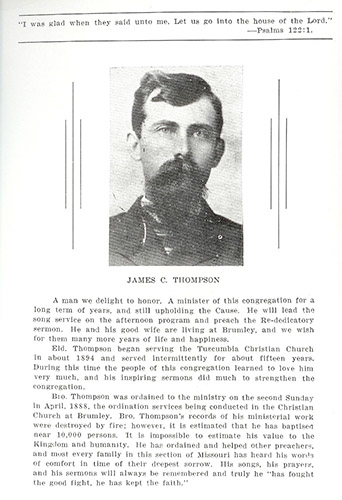
17 Reverend James C. Thompson
Click image for larger view
One room was the office, another was the kitchen and dining room, the third served as a bedroom and waiting room. Our furniture was given to us by Aunt Margaret and Uncle Jim. For lights we had a single burner Coleman gasoline lantern, a kerosene lamp and an Aladdin kerosene lamp loaned to us by Julia Jackson, a neighbor (photo 18).
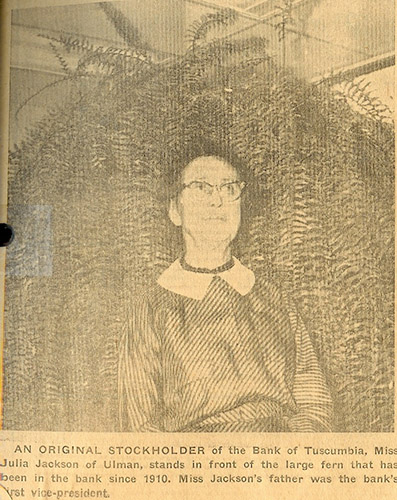
18 Julia Jackson
One bitterly cold night during January, I was called by phone to make a house call in the Bear Creek neighborhood. Bear Creek had to be crossed at a ford where previous cars had splashed water that had frozen on the banks of the stream. If I went too fast into the water it would splash onto the distributor and drown out the motor. So I drove in carefully but I didn’t have enough momentum to get over the ice on the bank. So I was stuck. I jumped to the bank from the running board of the car. I walked about a quarter of a mile to a house owned by Ira Beard, woke him up and he agreed to pull me out (photo 19).
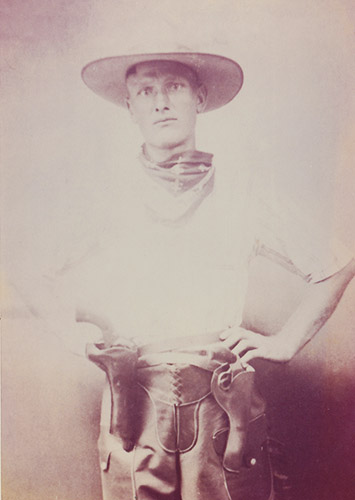
19 Ira Beard - 1910
He just caught one horse which was not strong enough to pull me out. He said, “You wait here while I go catch the other horse and harness him up.” By this time I was cold, so I started the motor which with the windows rolled up would warm the car from the hot exhaust manifold. About 30 minutes later Ira showed up with two horses and was able to pull me out. I went about another mile down the road to the house which was my destination. A very strange feeling came over me. I became dreadfully sleepy and nauseated. I hardly remember what I did at that house. Sometime later it dawned on me what had happened…this was another close call I have had with death…this time with carbon monoxide!
Ira Beard lived in a cabin in a remote section of the county four or five miles east of the Bagnell Dam. The cabin in which he lived was the hideout for “Pretty Boy” Floyd, the infamous gangster at the time (photo 20).
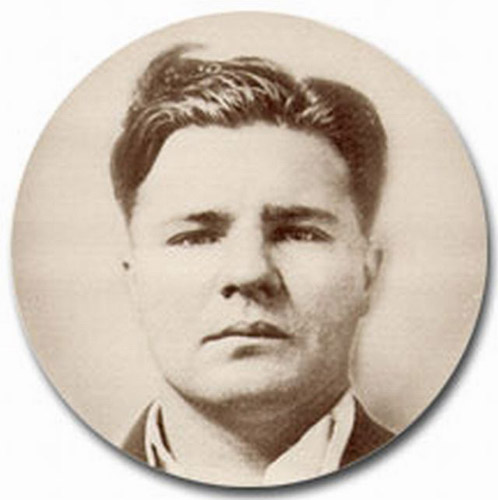
20 Charles Arthur "Pretty Boy" Floyd
Floyd had married a Beard girl, a cousin of Ira. She had brought him to this cabin during his years of evading the law. Soon “Pretty Boy” would be trapped in a wheat field in Ohio and shot down. It was after Floyd had left the area that Ira moved in. Ira and his wife, Lottie, had six children when we came to the area in 1933. It was my privilege to deliver six more for Lottie before the menopause set in.
The cabin was a two room affair with an attic where all the children slept except the baby. In the kitchen were a wood stove and a table where the meals were eaten. In the second room was a bed for the man and wife, the baby makes three. Some homes had a home made cradle for the baby. Every cabin had a fireplace for heating where you would freeze on one side and burn on the other. I was at first puzzled by a mottling brown discoloration of the shins of many of the girls and women that came into my office until one of them explained that it was the heat from the fireplace that caused it. One day a spark from the fireplace landed on the shake roof and before Lottie knew about it the house was beyond any hope of salvaging. She was alone with two pre schoolers; her first thought was to get the children out, which she did. Then she thought she might have time to save a few possessions. When she went back into the burning house, unbeknown to her, one of the children followed her in and crawled under the bed. When she saw him she tried to get him to come out but he would not. After a frantic effort she did pull him loose and carried him to safety outside; but she could only stand helplessly by as the home burned to the ground.
This did have a happy ending as the word got out. People began sending clothes, the Red Cross sent bedding, and a neighbor with a saw mill moved his rig to the site while the men hauled in logs and began and constructed an eight room two story house. Months later I was talking to Ira. He said, “The one item that we regretted losing the most was the pressure cooker.”
Our next door neighbor was Jim Dickson, a rural mail carrier. He lived in the biggest and perhaps the best house in town. He had inherited it from his father who was a medical doctor before his death about 1930. As a postal employee Jim had the best income in town but he was an alcoholic. Not only would he go on frequent binges but he would do things like leaving water in his auto radiator which on a cold night would burst the radiator but would also burst the engine block. Since his job depended on a serviceable car he had to pay for expensive car repair or buy another car. I had no idea that his financial condition was so bad until the spring of 1935 when the banker, Ted Hawkins, came to me with an offer to take over Jim’s property (photo 21).
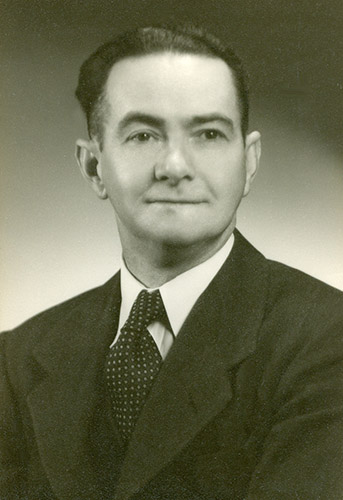
21 Senator Ted Hawkins
I told Ted that I didn’t relish the idea of putting the Dickson family out of their home. He said it wasn’t a matter of putting anyone out of their home, that Jim had not paid his taxes for over three years, that he had not paid the interest on the mortgage in over three years, that the tax collector was making plans to evict Jim and sell the property for the delinquent taxes. Ted went on to say, “If you will pay up the back taxes and assume a mortgage for what is owed the bank you will help us out of a bad situation. So that is how we came into the possession of an eight room house made of lime and rock, walls over a foot thick, the lumber in it was black walnut. The living room was 14 x 22 feet. Jim came to me wanting to trade cars, his 1930 Chevrolet Coupe for my Ford Coupe, 1926. I found that he was 5 months in arrears with his payment of $9.00 monthly. So I updated my transportation. To make matters worse, Jim had been fired from his job and that is another story.
To understand the firing of Jim Dickson from his mail route you will need to know some of the political climate of the time. The depression was now at its deepest extent. The Republicans had been in power all through the twenties but now Franklin D. Roosevelt was in power. Jim had gotten his job under the Republican regime but under the civil service system a person could not be fired from a job except for a crime or dereliction of duty. Jim believed that a Democrat by the name of Ottie Warren had turned him in when a substitute had to take the mail when Jim was getting over a drunk spell. So after Jim lost his job he found some booze to get drunk again. He bought a hand gun and went down to the post office to wait until Ottie Warren came to town, then planned to get even. The post office was in the home of Arthur Phillips (photo 22).
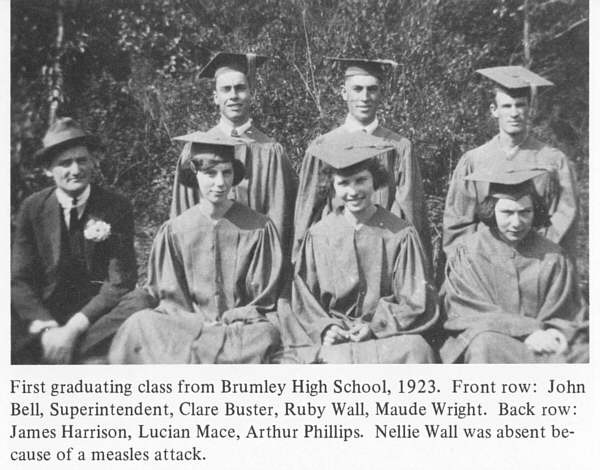
22 Arthur Phillips - Back Row Right
The mail was sorted for rural delivery and was to be placed in boxes in a room in the back. Those that got their mail in town had to go to the post office and open their own box. On this particular day when I went to get our mail Jim Dickson was there with a revolver in his hand, waving it around and telling us what he was going to do to Ottie Warren. I looked through the open door into the Phillips’ living quarters where lay a baby just a few months old. There were several men in the post office along with Arthur Phillips who seemed hypnotized by the harangue Jim was putting out. My first thought was for the safety of the baby and his mother, Beaulah Phillips. I was within five feet of Jim when I entered the room and knowing that drunks have very slow reflexes, I closed the distance in nothing flat, grabbed his wrist with my left had, the gun by the cylinder and brought my knee up hard against his hand. This broke the grip he had on the gun. On the way home from the post office I stopped off at the Dickson house and gave Mrs. Dickson the gun. She was the only one of all the people involved that thanked me. Mrs. Dickson returned the gun to the man that sold it to Jim and got the money back. Money she needed, a gun she didn’t need.
Jim moved with his family to Jefferson City where he got a job as a guard at the penitentiary. The last I heard of him he and the family were getting along fairly well.
One bright sunshiny day I was called to a farm where the only boy of the family (with his six sisters) had gone hunting. He had a 410 shotgun and had seen a rabbit run into a pile of brush. He had picked up the gun by the end of the barrel and was poking into the brush pile with the gunstock. A small limb must have triggered the gun because it went off and the whole load entered his skull beneath the chin. He dropped the gun, turned and ran about 100 feet, then fell dead. The coroner reported that his skull was fractured in dozens of places, much like an egg shell.
One of the farmers came to my office with a minor complaint. After treating the condition he asked me for a diagnosis. Jestingly I told him that he was just plain lazy. He said, “Doc, I can’t go home and tell my wife that. Don’t you have another name for it?” I said, “The Greek word for work is Ergo, the Greek word for fear is Phoria; you have Ergophobia” Ever after that when ever I would see him he would ask me the name of the disease he had.
A young woman, obviously pregnant, came in to the office wanting to know what my charges were for delivering a baby. I explained that I would see her every month until the last two months then I would need to see her weekly. At these visits I would take her blood pressure, a blood count, a urine test and manipulate her lower spine and pelvis bone so that the joints would be loose at the time of labor. Then I would deliver her baby…all of this for just $20.00. She lived near the town of St. Elizabeth. She said, “There’s a doctor in St. Elizabeth that would deliver me for $10.00. I said, “Fine, why don’t you get him to do all that I promised to do for you for ten dollars? She said, “But I want you.” I replied “My price is twenty dollars.” She said, “Dr. Kouns at Tuscumbia said that he would deliver my baby for $15.00.” I said, “Dr. Kouns has had 50 years of experience and should do you a good job, why don’t you get him?” She replied, “I want you!” I did deliver the baby for her for $20.00 (photo 23).
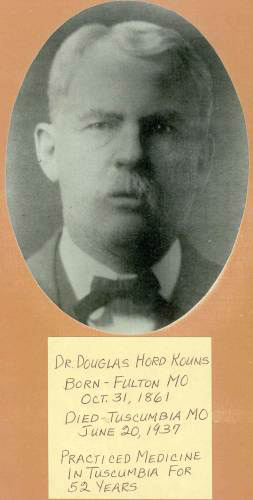
23 Dr. Douglas Hord Kouns
There were only two other buildings on the Dickson property when we bought it; a smoke house and an out door privy. The first improvement we did was to build a woven wire fence around the entire property of 2 acres. A man who owed me considerable money agreed to build the fence. In digging holes for the corner posts he found solid rock within a few inches of the surface. Like most farmers in that area he was able to use dynamite. My nine year old brother, Terry, had never seen anyone use explosives before; he said he hoped that Mr. Robinson had to use dynamite on every hole, but as it turned out only two places needed it. A short time later, Rawl Devore and his cousin Ralph Devore, built a little shed, as a milk barn for our newly acquired cow. Later we built a modern type of privy; a garage that could be heated in the winter; the same stove that heated the garage would also heat water for the washing machine which was electric. We had made the garage long enough to accommodate the washer. Much later we built a fruit cellar with a flat roof so that we could build a building on top in case our smoke house fell in. During the last two years we were at Brumley we tore down the cracked cistern and back porch of the house. Our well water was exceedingly “hard” so that taking baths, washing clothes, dishes and especially for washing hair it was not satisfactory at all. It was my dream to replace the defunct cistern with a much larger one. I told Allie Plemmons, a carpenter, that I wanted a cistern 18 feet deep by 6 feet in diameter. After removing the old porch, they began to dig the cistern. Within 12 inches of the surface they ran into solid rock. Allie came to me and asked, “Wouldn’t it be better to have this cistern 18 feet long and only six feet deep?” So we called in a dynamite specialist, Luna Gan, to blast a hole 22 feet long, 6 feet deep and 10 feet wide. The top of the cistern became the floor for our new back porch on which we constructed a fine glassed in porch. We provided a small room to house the electric pump and tank, then for the first time we had running water in our home. We installed guttering on the eaves of the house, down spout drained into the new cistern which held in the neighborhood of 9,000 gallons. As far as we knew we were the only family in the whole countryside that had a cistern. The four Hawkins girls would come to get water when they wanted to wash their hair. Mrs. Swenehart came once or twice a week to get water for washing clothes. We were glad to share our water because this would use it up faster and it would be replaced more often making it better quality water. The last improvement we did before we moved away was to build a cesspool with tile pipe buried in the garden. We moved away before making a bathroom in the house.
During the time we were putting the finishing touches to the cistern, one of the men that habitually hung out at one of the stores downtown said aloud in the presence of Counts Garrison (90 years old), “As soon as Doc Jones finishes his cistern we take Counts Garrison up and put him in it!” Counts turned on him and said “It has been forty years since there has been any water on my back.” This was the truth!
Late one afternoon Counts came to get me to deliver his wife. Mrs. Garrison was 78 years old and Counts was 90. I’ll admit to being a bit skeptic. When we arrived at Counts’ house, she did look pregnant. She claimed that she felt movement and was beginning to have labor pains. It proved to be free fluid within the abdominal cavity due to congestive heart failure. She responded to digitalis and diuretics.
One morning a middle aged man came to my office to buy a bottle of paregoric. I asked him, “What do you want it for?” He replied, “I want it for colic.” “Who has the colic?” I asked him. He said, “My baby has the colic.” I asked, “How old is your baby?” “Three weeks,” he said. “Who delivered your baby?” “I did,” he said. Then he told me that when his first baby came many years ago that he watched every move the doctor made. Since then he had delivered all of his own babies. This baby was the eleventh one he had delivered.
Brumley had a grade school and a four year high school (photo 24).
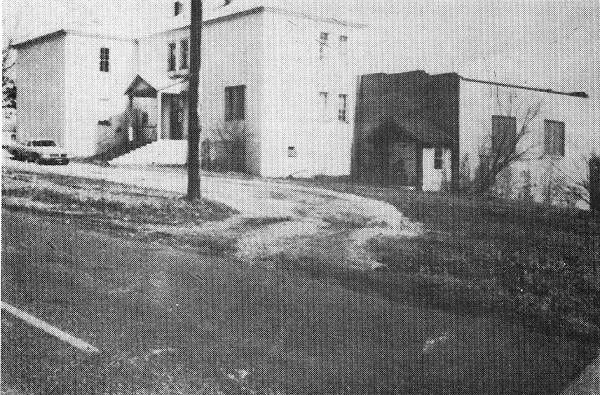
24 Brumley School
The grade school was divided into two rooms with four grades in each room. A teacher presided over the four classes in her room. At the end of the first semester the teacher of the four lower grades went to New Orleans to visit some relatives. While there she found another job. She wrote the Brumley school board that she wasn’t coming back. This left the Brumley school in a bind. The president of the school board, Charles Roosevelt “Ted” Hawkins, approached Marjorie, my wife, to ask her if she would finish out the school year. After signing the contract we found that Marjorie was in the first trimester of pregnancy. She was able to complete the school year without trouble.
It was during this time of teaching that we had to have help in our home. Bertha Shatto, Marjorie’s older sister, helped us out for about five weeks, then my mother came from Oregon, stayed to the end of the term and then returned to Oregon. My mother had brought Terry, my brother age 9 with her. In the early days of June we took mother and Terry to Kansas City where mother had surgery. After mother recovered sufficiently, Aunt Margaret and Uncle Jim took her and Terry on a wonderful trip back to Ohio, where she was born and where she had many relatives and friends.
As the time drew near for Marjorie’s delivery, we went to Kansas City so that Marjorie could stay with Aunt Margaret and Uncle Jim. I returned to Brumley to continue practice. It was 2 a.m. September 19, 1935 that I received a call from Aunt Margaret saying that she was taking Marjorie to the hospital, that I should come home immediately. I had to get Ted Stamper out of bed to open his gasoline station so that my tank would be full. I remember that the price of gasoline was 16 cents a gallon on that day. Even so, with a full tank I ran out of gas 18 miles from Kansas City. The Lord was with me for I had just topped a hill from where I could see a gas pump being filled with gasoline at a nearby store. I arrived at Lakeside Hospital about 7 a.m. Myron Douglas Jones Jr. arrived at noon!
Charley Johnson had a family of six children; he lived on forty acres of rock and stumps but managed to make an adequate living for his family. What he lacked in assets and knowledge he made up in hardwork and enthusiasm. He told me this story: “One day Joe Whittle of Iberia went to Jefferson City to visit a lifetime friend who had retired and bought a house there. Joe took his son, his son’s wife, his daughter and her husband. These five persons drove the 50 miles to Jefferson City arriving at his friend’s house to find no one at home. Finding the door unlocked and a fresh pot of hot coffee on the stove, they sat down to enjoy a cup of coffee. Soon they all became ill and were rushed to the hospital where Joe (70 years old) died. The doctors analyzed the coffee grounds and found that they were anchored in the pot; Joe had died of Ptomaine Poisoning! Actually, when Joe’s friend had moved to Jefferson City, he took his son and daughter in law with him. After a time, the son had died leaving the old man and the daughter in law. On this particular day, the daughter in law had put arsenic in the coffee. This was her version of “Social Security!” She did get security, however; she spent the rest of her life as a guest of the State of Missouri…in the penitentiary!
Mr. Joe George had been employed all of his working days in Jefferson City. Now at age 73, he had retired on a farm about a mile out of Brumley, along with his wife. One day he had hitched his team of horses to a wagon and went to the field to get a load of fodder. While riding on the wagon, he slipped off the front of the wagon, the wheel of the wagon rolled over his abdomen. Mrs. George went to a nearby neighbor for help. They carried him to the house while some one came to Brumley to get me. A few minutes later when I arrived he was lying perfectly still. He complained of very little pain, his heart rate and temperature were normal but I did find one very disturbing symptom….his abdominal muscles were stony hard. That had an ominous connotation…it meant that one of his abdominal organs had ruptured and no doubt was bleeding. His only salvation was for immediate surgery. This was what I told Mrs. George in the presence of several neighbors. She said, “Our only son who lives about five miles south of here is on his way. I want to wait for his arrival.” That seemed a reasonable request, so we waited. It wasn’t long until the son arrived. He asked me if he had any fever. When I answered no, he said, “With his temperature normal and his pulse normal there is no need to go to the hospital at this time.” I told him that his spleen was ruptured, that if he was not operated this very day he would surely die. The son (named Jody) said, “I feel that we can safely wait.” Again, I urged him to get his father to the hospital but Jody remained adamant.
Three days later I was again called to see Mr. George, the main concern being that his bowels had not moved since the accident. This time Jody and his mother agreed to let me take him to the hospital. When we arrived at the hospital in Lebanon, the surgeon met us at the door. I gave him the whole story after which the surgeon said, “The man is calm, has very little pain, his pulse is normal, he has no fever. I am sure he is going to be all right; I’ll watch him for a few days and I will keep you posted on his progress.” Then I left. Two days later, Mr. George came home….in a coffin!!
In the spring of 1934 the Brumley School district decided to build a gymnasium onto the existing school building using WPA funds that had become available. A farmer by the name of George Withers applied for a job on the project as a carpenter. The foreman on the job was dissatisfied with George’s work so he told him to report to another WPA project of building a county road. To George, this was a great humiliation to be reduced from a carpenter to that of a laborer. He went to the only phone available to him which was located in one of the three general stores in town. Everyone in the store could hear George’s end of the conversation. George had put in a call long distance to the governor’s office in Jefferson City. The governor then was Guy Park. When his secretary answered the phone George said, “This is George Withers; I want to speak to Governor Guy Park and I don’t want to speak to any of his underlings!” Surprisingly, the secretary connected George’s call directly to the governor. George then said, “I have a matter of utmost importance to discuss with you; I want to congregate with you as soon as possible.” The governor granted George an audience but nothing came from it because George reported to the road project the next day!
In the spring of 1936 there was an epidemic of influenza with numerous complications. This was before sulfanilamide, penicillin or any other of the miracle drugs had been available. The use of osteopathic manipulation cut down on the mortality, even so, two patients died of pneumonia that possibly could have been saved with penicillin. George Withers developed pneumonia during this time. He was in a delirium for a whole week. As was the custom in the rural Ozarks, many of the neighbors would come in to help with the nursing, some would bring in food, chop wood for the fires and be generally supportive of the patient and family. On this occasion a teen age boy had come in to help with the nursing. Reed Martin was a very fine boy but was considered slow witted. But he did a wonderful job nursing George back to health. After six days of delirium George suddenly returned to his right mind. That morning when I arrived, Reed met me at the door with a big grin on his face and said, “When George woke this morning, he “knowed everything!”
George had two neighbors that came very early every morning to split wood and fill the wood box before they went off to their jobs. These were Rawl and Ralph Devore, uncle and nephew. Their wives would come in to help do the cooking and washing of the dishes and clothes. Anyone in trouble always had plenty of help.
Years went by with George doing odd jobs, his wife and five children raised chickens, hogs and a couple of cows. They had a subsistent living. Finally, George had an opportunity to get rich…he became manager of Lacus Lodge (photo 25).
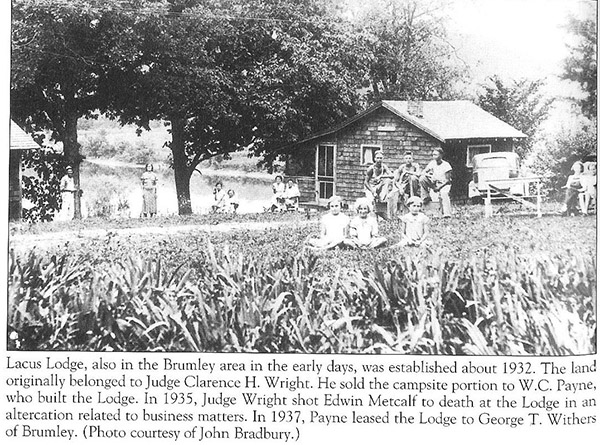
25 Lacus Lodge
This was a resort where you could rent cabins, rent boats for fishing, and get away from it all. Somehow it didn’t work out quite the way George had envisioned it would; the only clientele were the local young men who were interested in bringing young women into the cabins or play poker. There was a middle aged widower that lived near Ulman who rented a boat to go fishing. George consented for his wife to be the fishing guide. As George soon found out, there was more than fishing that went on during these excursions up and down the lake. But he tolerated it as long as the fishermen paid their bills. Finally came a day when Wolf Dawson, the fisherman, decided to break off the relationship with George’s wife but she would have none of it. She would arrange a clandestine meeting with Wolf on a frequent schedule. George finally caught up with them in a cabin three miles north of Ulman. George broke in on them with his gun blazing. He shot Wolf three times, made his wife get into his car, and drove home. After they left, Dawson got into his car and drove to the hospital in Jefferson City where they dressed three minor wounds and gave him a tetanus shot.
The next day Wolf came to my office for dressings where I found a skin abrasion on the scapular area; a bullet hole through the triceps of the upper arm and a bullet hole in the buttocks with the bullet still imbedded against the femur. Wolf came for dressing changes daily until all the wounds were healed which actually didn’t take very long.
George was arrested by the sheriff and charged with criminal assault. But when he was brought to trial, Wolf refused to press charges. So the judge asked George if he would plead to disturbance of the peace, which George agreed to do. He was fined $10.00 and told to leave the state. About two weeks later George came into my office to settle up his account with me. After paying his bill he told me that the only thing about the whole affair that he hated most was that people would think he was a might poor shot!
His business venture was a failure, he was forced to leave the state, his children were corrupted, his family was disgraced and his only regret was that his peers would discuss his poor marksmanship!
A Mr. McClaskey, aged 84, was hauling corn fodder on a flatbed wagon. Mr. McClaskey was sitting on top of the load when the front wheel dropped into a small rut throwing him forward onto the frozen ground. He landed on his upper spine which was fractured. The neighbors were summoned and one of them drove three miles to Brumley to get me. He probably had laid on the frozen ground for over an hour before I could get there. Before I left town, I summoned an ambulance from Iberia instructing the driver on the location of the injured man. Mr. McClaskey was lying in the middle of his cornfield about 150 yards from the nearest road. I took my axe from the trunk of my car as well as two blankets. I cut two sapling trees and with the blankets made a stretcher. With the help of four men we moved him onto the stretcher and brought him to the ambulance. I instructed the ambulance driver to take Mr. McClaskey to Lebanon, Missouri to the hospital there. Mr. McClaskey lived only two days, the cause of death attributed to renal failure. About nine months later, I was called to see Mr. McClaskey’s widow, Ina. She was about 81 years of age, slightly obese and had developed a strangulated hernia. I explained to her in the presence of half a dozen neighbor women that strangulated hernias do not cure themselves and that they are 100 % fatal unless operated within 24 hours. I told her she had an excellent chance of survival if we could operate within the next three hours. I went on to explain that time was of the essence; a twelve hour wait would reduce her chances by half; only a few survive after 16 hours and that for a 36 hour wait no one survived. She replied, “I’m not going to the hospital.” “Evidently, you didn’t understand what I said” I replied. “I am talking about your life!” She stubbornly refused to go after half an hour of persuasion. I finally told her, “I am now leaving; I am begging you to call any physician of your choice so that you can get a second opinion, and please do what ever he tells you!” She did call another doctor….2 days later! He told her the same thing that I had, she still refused to go. It wasn’t until the 6th day that she called me because now she had excruciating pain. She said that she was ready to go to the hospital. I said to myself, “Ina you may have waited too long.” However, what I said to her was “What I am going to do is to give you morphine to relieve your pain but you cannot live more than 24 hours if you don’t go to the hospital.” However, unfortunately, she was dead the next day.
In the spring of 1936 there developed an epidemic of Scarlet Fever and erysipelas. The adults of the family would develop erysipelas as a rule while the children would have Scarlet Fever. Sometimes the reverse occurred rarely. New cases usually had direct contact with someone sick with the disease. This was a year before sulfanilamide but Streptococcus anti toxin was then available. All of my cases survived even though I gave the antitoxin to only one patient, a new born baby with erysipelas whose mother had the disease at the time of delivery. This family, though they lived nearer Brumley than Iberia, had elected to have the Iberia doctor. He was out of town when the baby became ill, so I inherited a bad situation. The baby was critical for four days but finally recovered.
I was at the end of this epidemic when I came down with Scarlet Fever. Marjorie called Dr. Adam Berkstresser of Eldon to see me. After Dr. Berkstresser returned to Eldon, he called Dr. J.L. Jones in Kansas City to tell him how sick I was. Dr. J.L. bought an ampoule of Scarlet Fever antitoxin and drove down the next morning to inject the medicine. The next day I developed a severe rash from the horse serum so I told Marjorie to give me 1 c.c. of adrenaline. This was an overdose; my heart began to pound to the extent that the bed was vibrating with each heart beat. Marjorie was frightened; she placed her body over mine to lessen the vibration. In about twenty minutes the pounding subsided and I felt good. My rash cleared the next day and the Scarlet Fever rapidly disappeared.
Earlier that year Brumley had an election to elect their councilmen. Ted Hawkins had asked me to run for that office to which I had agreed to do. So I had been duly elected to the office. After the election the five councilmen had a meeting to elect the mayor, secretary and treasurer. While I was still in bed recuperating from the Scarlet Fever, the Mayor came to see me on the way to the organizational meeting. He asked me if there was anything he could do for me. I answered “Yes, you can elect me mayor of Brumley!” I was 100% joking, of course, but an hour later as Preacher Jim Thompson was returning from the meeting he stopped again to see me, this time to congratulate me as the newly elected mayor of Brumley!
I had difficulties getting help with my deliveries; there were usually plenty of neighborhood women that were willing to assist me but they left much to be desired in the handling of my sterile instruments, towels, etc. My sterile rubber gloves were wrapped in several layers of cloth and put in the top of a double boiler for an hour. My gowns were wrapped in several thicknesses of newspaper and placed in an oven until the paper turned a light tan. The towels and sheets used in the delivery were sterilized likewise. The instruments were immerged in alcohol, the solution to prepare the patient was Lysol made up with boiling water. Before I donned my gown and rubber gloves I would scrub my hands 20 minutes with a sterile hand brush, soap and water. I was able to teach Marjorie my technique for handling sterile articles without contamination. Imagine my consternation on a delivery in a log cabin one day! Marjorie was not with me this time and the only help was the patient’s mother who had been a midwife in the past. After preparing the side table with the opened packages, I put the instruments in a pan with alcohol over them. I asked for some soap so that I could scrub up before I donned my gown and sterile gloves. The search for the soap took all of ten minutes. The girl’s mother came to me telling me to hurry, that the cervix was fully dilated and that the baby’s head was on the perineum. I asked her “How do you know this?” She replied “I just examined her!” All my preparation was for naught! The delivery was easy but for several days afterward the girl ran a fever of 101 degrees! Evidently, she was immune to her environment because she recovered fully.
A few years later, the husband attempted to start a fire in the kitchen pouring kerosene from a can. Evidently, there were some live coals in the firebox because the kerosene exploded and he was horribly burned over 95% of his body. He died within hours of the accident.
The same thing happened two other times in our community. A young wife from a prominent family in Ulman and a middle aged farmer along the Wet Glaize River south of Brumley were burned by pouring kerosene on a fire. Both died. One other fatal burn resulted when a toddler fell into a pan of boiling water his mother was using to scrub the floor. The scald was over 40% of the body. Since then several burn centers have evolved and with today’s knowledge probably could have saved the child.
In the fall of 1936 Marjorie became pregnant for the second time. With our expanding family we found it necessary to get a larger car. For over a year we had got along fairly well with the Chevrolet Coupe that we had acquired from Jim Dickson. So we bought our first brand new automobile, a two door Chevrolet. The cost was in the neighborhood of $600. Today in 1983 that car would cost in the area of $6000.
On July 17, 1937 Eula Margaret Jones was born. Oh! What a beautiful baby! We fell in love with her immediately and she has been a blessing to us ever since. Financially, we were $2,000 in debt but with Myron D, age two and now Margaret, we became millionaires!
One of the high school boys lived on the Wet Glaize River. He came to school one morning bringing a 30 pound catfish with him that he had caught the evening before. He would wade in the shallow part of the river feeling under tree roots and rock ledges until he felt the slick body of the fish. He would slide his hand along the body of the fish until he came to the mouth. He then would grab the fish by the under jaw, then would start walking out from the stream. He kept us supplied with fish for several years. We would cut the fish into steaks, put them in the freezing compartment of our refrigerator, and eat fish whenever we wanted! One weekend we planned a trip to Milan. I contacted our young fisherman and placed an order for two catfish. He delivered two very large fish, one weighed 40 pounds! The other weighed more at 42 pounds! We laid a wet gunny sack on the floor of the car and covered the fish with another wet sack. Five hours later when we arrived in Milan the fish were still breathing.
About 5:30 one morning the door bell rang. It was just barely daylight. A young man wanted me to deliver his wife. He lived atop a hill about two miles west of Brumley. We had to drive over a mile to a trail that crossed the Mill Creek, then up a very steep hill to a log cabin. When we arrived the girl’s mother jumped all over me for taking so long to get there as the baby had arrived two hours earlier. I protested, “It has been only 30 minutes since your son in law rang my door bell!” She whirled on her son in law, “Where have you been since 2 o’clock?” He replied, “I’ve been in the cabin over there by the creek.” He was afraid to walk the two miles in the dark!
One night, Marjorie and I took my Aunt Bernice and Uncle Fred fishing down by the bridges where the river (Wet Glaize) ran into the Lake of the Ozarks.
Note: Two swinging bridges in that area were Auglaize and Mill Creek bridges (photos 26 and 27).
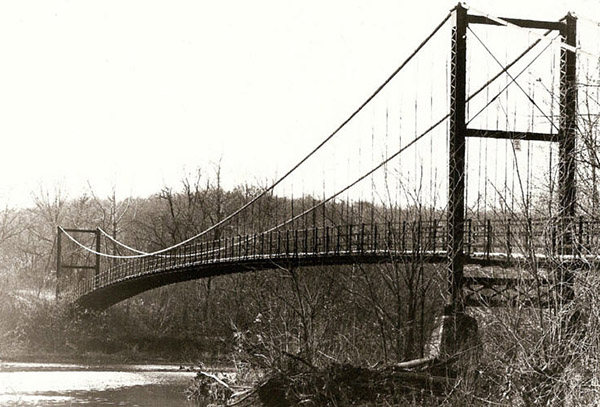
26 Auglaize Bridge
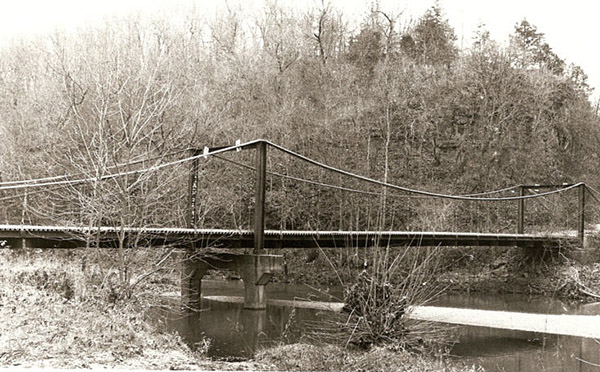
27 Mill Creek Bridge
We were fishing by flashlight. It was quite dark when up the valley we heard a man’s voice calling “Oh! Doc!” I yelled out to answer the call. It was “Pickle” Ames wanting me to deliver his baby! Bernice whispered to me that she would like to help me. “I’ve had two babies of my own but have never witnessed a birth.” I welcomed her help. When we arrived at the cabin where Mr. Ames lived we found the house in darkness. The kerosene lamp had gone out due to lack of fuel. While Mr. Ames went to a neighbor’s house to borrow kerosene, I could tell by the tone of Mrs. Ames’ cry that she was ready to deliver. I told Bernice to hold the flashlight while I attended the mother. Bernice held on to the flashlight but it was wobbling something awful.
In June of 1938 one of the WPA workers was transferred from Olean, Missouri to Brumley. Soon after he and his wife moved she came to my office complaining of pain in the abdomen and an incision that would not heal. She gave a history of an operation for appendicitis three years before. The operation was performed by a general practitioner in a make shift hospital in Eldon, Missouri. The doctor who did the operation was of the variety that delighted in “putting the knife” into any and all Osteopathic Physicians, then twisting the handle. He had never missed an opportunity to say a disparaging word about me. After I finished my examination I told her that she had a foreign body in her abdomen and that it had to come out. I suggested that she go back to the surgeon that did it and that I felt sure he would be glad to remove it. My thinking was that he would be able to control the news about the incident better than an outsider. Esther did go back to him but he went into a rage, ordered her out of his office. Bewildered, she went to the office of a long time friend of hers, an Osteopathic Physician, Dr. Berkstresser, who was a classmate of Dr. J.L. Jones and a good friend of mine also. He called me to tell me that he was taking her to Kansas City to the Conley Hospital under the care of Dr. Margaret Jones. Dr. Margaret called me to tell me that the X-Ray showed the presence of a hemostat in the abdomen. She wanted me to come up for the scheduled surgery the next day. Dr. Margaret had cautioned those present at the X-Ray room not to say anything about the findings as she did not want the newspapers to get wind of it. Early in the evening a reporter of the Kansas City Star called Dr. Margaret on the telephone. Dr. Margaret figured that the fat was in the fire, so she invited the press to appear at surgery time with cameras to really document the whole proceedings. At surgery, we found that the hemostat had pierced the small intestine in two places, in making the repair 18 inches of the small had be removed. You can read about this case in the June 1938 Life Magazine or in the Kansas City Times Circa June 18th, 1938. Esther sued the doctor in Eldon and got $4500 in judgment. An interesting sequel to this story was that Mr. Cornett sued the doctor for the loss in the use of his wife for three years. When the suit came to trial, the defense told Mr. Cornett he was under oath…then asked him to name the date of his marriage to Esther. Mr. Cornett looked at the floor and answered “Yesterday!”
Joel Wall told me this true story: Joel was disking his field one day when he looked south to see several persons gathering at the church yard to dig a grave for one of the neighbors who had died. Joel tied his horses to a tree and walked the mile up to the top of the hill to offer his help in digging the grave. When he neared the gravesite, one of the men told a young woman with a new baby, “This man will do.” Where upon the young lady asked Joel to accompany her to a nearby spring to give the baby a drink from his shoe. He thought she was pulling his leg, but soon found that she was in dead earnest; her baby had “Thrush” (Candida Albicans), a fungus infection of the mouth and throat seen almost entirely in new borns. So Joel went over to the spring with the young mother, took off his shoe, dipped it in the spring water and then dumped the water out as he had been walking in loose dirt and his shoe was full of dirt. “No! No!” she yelled. “It has to be the first water!” So he took off the other shoe and handed it to Mrs. Witt. The baby did survive but it would have without treatment as this usually is not a very severe or long lasting condition. Six years later I was called to see this very same child. When I told Mrs. Witt her child had the chicken pox, she said, “I am sorry I called you.” I answered, “Why are you sorry you called me?” I wanted to know. She responded, “I can cure chicken pox myself.” I asked, “What is your treatment?” She replied, “All you have to do is take her out to the chicken roosts and pass her under three times!”
One day while waiting on the stork, I looked out the window and saw a little girl age 3 ½ furiously smoking a pipe. She really was making it fog! I asked her grandmother where she had learned to smoke. The grandmother replied, “When she was two years old she would sit on her grandfather’s lap while he was smoking. She would take the pipe out of his mouth and take a few puffs. Later when she was in the first grade I asked her how she handled her habit. She said, “I take two cigarettes, smoke one just before I get in sight of the school and after school going home I smoke the other one!”
Marjorie went with me on a delivery one night. When we arrived the labor pains had subsided somewhat. I asked if there was a bed that Marjorie and I could get a little rest until the pains started up again. One of the neighbor ladies put clean sheets on a bed in the adjoining room. We closed the door, Marjorie took off her dress and got into bed. Before I got in I took my flashlight to have a look at the edge of the mattress. There I found hundreds of bedbugs! Marjorie started getting up right then, but I told her that we’d have to stay a little while, that it would take thirty minutes for the bugs to get warmed up enough to crawl. So in thirty minutes we got up and dressed and went back into the other bedroom when we found that the mother was ready to deliver. We didn’t take any bugs home with us!
One of the diseases that was prevalent around the Lake of the Ozarks was malaria. Most of these patients had typical fevers on alternate days. I always sent a blood smear to the state laboratory in Jefferson City where the diagnosis was confirmed. For years the average number of cases was between 30 to 36. About 1942 a new drug came out that broke into the human/mosquito cycle. After that I had no more malaria to treat until five cases came home from the war with chronic malaria. These men had had the new drug, Atabrine, so I used a method given me by an old doctor from Brunswick, Mo. This was to put them in a bath tub bringing the temperature gradually up to 110 degrees keeping it there for an hour. This has never failed to cure chronic malaria in my experience. I successfully treated a child of 18 months with acute onset malaria who was too young to swallow the medicine.
Another disease found around the Ozarks was tularemia (rabbit fever). Twenty four of the victims I treated were persons that handled a diseased rabbit. The other 12 were victims of tick bites; evidently, the ticks had fallen off sick rabbits. All 36 patients recovered promptly using a combination of Osteopathic Manipulation and lymphatic pump. Two of the patients had had several weeks of unsuccessful treatment by area doctors but responded dramatically and promptly to Osteopathy.
Another endemic disease that I had plenty of experience with was Typhoid Fever. Most of the patients came form the Kaiser area. When I found a case I would offer to vaccinate the entire neighborhood. This did keep the disease to a minimum. I only lost one case of this fever in the 13 years I practiced in the Ozarks.
The obituary of Dr. Jones, who passed away in 1989, offers more detail about his life and career:
Dr. Myron Douglass Jones Obituary
Smith Funeral Home
Sunnyside, Washington
Dr. Myron Douglass Jones, 81, of Sunnyside, died Tuesday, March 14, 1989 at the Sunnyside Community Hospital.
He was born October 27, at Endicott, Washington to Albert and Ruth Jones. His earliest years were spent at Endicott. He later moved with his family to Fallon, Nevada where he graduated from high school. He attended the University of Health Sciences College of Osteopathic Medicine in Kansas City, Missouri and was graduated in 1929. On August 12, 1934, Myron D. Jones and Marjorie Shatto were married at Milan, Missouri. Dr. Jones practiced medicine at Brumley, Missouri from 1933 until 1947, when he moved to Kansas City, Missouri. In 1951 and 1952 he entered a Pediatric Residency in Philadelphia, Pennsylvania. Following his residency he served as Chief of Pediatrics at
University of Health Sciences College of Osteopathic Medicine in Kansas City from 1952 until 1972 when he retired. His wife, Marjorie, died in 1983.
On January 16, 1985 he married Alma (Bos) Green in Kansas City. In June of 1986 they moved to Sunnyside where he continued to make his home until the time of his death.
He was a former President of the American College of Osteopathic Pediatricians; a member of the Gideons International; the Masonic Lodge; and a member of the Sunnside Christian Reformed Church.
Dr. Myron Jones is survived by his wife, Mrs. Alma Jones of Sunnyside; a daughter, Margaret Johnson of Richmond, Texas; two sons, Dr. Myron D. Jones of Arlington, Texas and Dr. John Phillip Jones of Albany, Ohio; seven grandchildren; four sisters: Frances Ione Hall of Vancouver, Washington; Marjorie Nell Varner, Ruth Ina Penninger and Delma Jean Klassen, all of Grants Pass, Oregon; a brother, Terrill Andrew Jones of Grant Pass, Oregon and numerous nieces and nephews. He was preceded in death by a sister, Grace Winifred Jones who died in 1932.
Funeral services will be held Friday, March 17, 1989 at 2 p.m. in the Sunnyside Christian Reformed Church. Burial will be in the Lower Valley Memorial Gardens, Sunnyside under the direction of the Smith Funeral Home, Sunnyside.
Those wishing to honor his memory may do so by contributing to the Sunnyside Christian School or the Heart Fund. Memorials may be left at the Smith Funeral Home or at the Church at the time of services.
Thus we come to the end of Dr. Myron Jones’ autobiography. I never met him but according to my mother in law, Elva Boyd Steen, he was a very prominent and well liked physician during the years he practiced in Miller County.
 Joe Pryor
Previous article links are in a dropdown menu at the top of all of the pages.
|

